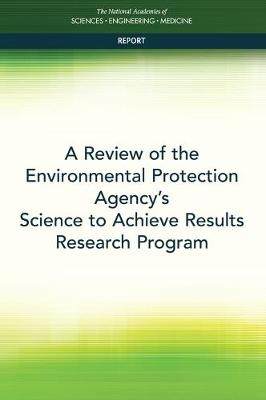
A Review of the Environmental Protection Agency's Science to Achieve Results Research Program
Seiten
2017
National Academies Press (Verlag)
978-0-309-45857-3 (ISBN)
National Academies Press (Verlag)
978-0-309-45857-3 (ISBN)
Environmental research has driven landmark improvements that led to the protection of human and ecosystem health. Recognizing the value of knowledge generated by environmental research and the ingenuity within academic and nonprofit institutions, the US Environmental Protection Agency (EPA) created a program known as Science to Achieve Results, or STAR, in 1995. STAR is EPA's primary competitive extramural grants program.
A Review of the Environmental Protection Agency's Science to Achieve Results Research Program assesses the program's scientific merit, public benefits, and overall contributions in the context of other relevant research and recommends ways to enhance those aspects of the program. This report also considers the conclusions and recommendations of a prior National Research Council review of the STAR program (2003), the STAR program's research priorities in light of the nation's environmental challenges, and the effects of recent STAR funding trends on obtaining scientific information needed to protect public health and the environment.
Table of Contents
Front Matter
Summary
1 Introduction
2 The Scientific Merit of the Science to Achieve Results Program
3 Public Benefits of the Science to Achieve Results Program
4 Research for Addressing the Environmental Protection Agency's Priority Scientific Questions
5 Findings and Recommendations
Appendix A: Biographical Information of the Committee on the Review of EPA's Science to Achieve Results Research Grants Program
Appendix B: Summary of the Previous Reviews of the Science to Achieve Results Program
Appendix C: Assignment of Science to Achieve Results Request for Applications to Scientific Domains
Appendix D: Assignment of Highly Cited Science to Achieve Results--Funded Papers to Scientific Domains
A Review of the Environmental Protection Agency's Science to Achieve Results Research Program assesses the program's scientific merit, public benefits, and overall contributions in the context of other relevant research and recommends ways to enhance those aspects of the program. This report also considers the conclusions and recommendations of a prior National Research Council review of the STAR program (2003), the STAR program's research priorities in light of the nation's environmental challenges, and the effects of recent STAR funding trends on obtaining scientific information needed to protect public health and the environment.
Table of Contents
Front Matter
Summary
1 Introduction
2 The Scientific Merit of the Science to Achieve Results Program
3 Public Benefits of the Science to Achieve Results Program
4 Research for Addressing the Environmental Protection Agency's Priority Scientific Questions
5 Findings and Recommendations
Appendix A: Biographical Information of the Committee on the Review of EPA's Science to Achieve Results Research Grants Program
Appendix B: Summary of the Previous Reviews of the Science to Achieve Results Program
Appendix C: Assignment of Science to Achieve Results Request for Applications to Scientific Domains
Appendix D: Assignment of Highly Cited Science to Achieve Results--Funded Papers to Scientific Domains
| Erscheinungsdatum | 13.08.2017 |
|---|---|
| Verlagsort | Washington |
| Sprache | englisch |
| Maße | 152 x 229 mm |
| Themenwelt | Studium ► 2. Studienabschnitt (Klinik) ► Pharmakologie / Toxikologie |
| Naturwissenschaften ► Biologie ► Ökologie / Naturschutz | |
| Sozialwissenschaften ► Politik / Verwaltung ► Staat / Verwaltung | |
| ISBN-10 | 0-309-45857-9 / 0309458579 |
| ISBN-13 | 978-0-309-45857-3 / 9780309458573 |
| Zustand | Neuware |
| Haben Sie eine Frage zum Produkt? |
Mehr entdecken
aus dem Bereich
aus dem Bereich
Buch | Hardcover (2024)
Thomas Karow (Verlag)
CHF 79,95
Buch | Hardcover (2022)
Urban & Fischer in Elsevier (Verlag)
CHF 138,60


